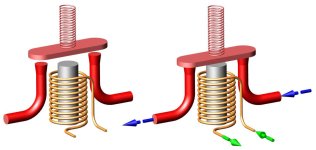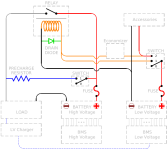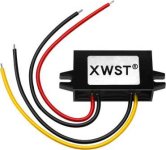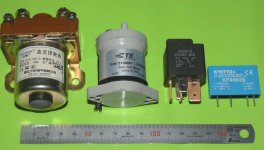harrisonpatm
10 kW
- Joined
- Aug 8, 2022
- Messages
- 824
I thought I'd start a new thread split off from this one to discuss DIY BMS contactors at length. Planning stages for my next build.
I'd like to use the salvage contactors I got from Battery Hookup for this one (https://batteryhookup.com/products/te-connectivity-ev200aaana-500a-0-900vdc). Contacts are rated for up to 900v, coil activates at 8-36V, so that's the first issue. For a high-discharge EV, you'll be using a battery pack anywhere from 48-108v nominal. So you'd need to get the voltage down to the coil's rating. Normally I'd use a DC/DC buck converter. But as the BMS is in control of the contactor closing, you don't actually want it running 24/7 with the BMS. So you'd want to put a key switch (ignition? handlebar switch?) in line, in between the BMS and the coil. So how do we get the voltage leaving the BMS down to 12v first, then to the contactor coil? If you were to use a buck converter, you'd still need to have a way to switch the V-in on and off manually, and when you're working with 72-108V packs, that's a big switch, I'd rather switch 12v.
In another thread, I saw someone use a DC/DC converter that operated off a key switch on the input, so that you could work it to not have the converter running 24/7 just to have 12V available to switch on the contactor. That'd be cool, but I'm not sure whether that keyed input is 12V or pack voltage, and I'd rather not switch pack voltage, even at low amps. Has anyone used a specific model of DC/DC buck converter that has a key switch input that can be switch with a relatively cheap switch?
Google has suggested that I use math to find out what resistive load I could place in line with pack voltage and the 12v coil to make it 12v. Or linear voltage regulators is another things I came across. I'm just not familiar with those, maybe someone else is.
I would also want to place the charging leads through the BMS, and not through the contactor. This way I could charge the EV without having to close the contactor. So you would still need a BMS rated high enough to handle your planned max charging current. That shouldn't be a big deal, as charging current is usually not nearly as high as discharge current. Besides, the concept of using a cheap BMS to control a contactor is only good if you have a BMS that's still good enough to monitor series voltages reliably. Therefore, even though this method is a way to not have to use a super expensive BMS, you'll still want a decent and reliable one, and it should be able to handle 20-50amps of charging no problem.
Anyway, up for discussion. I'd love some suggestions on powering a 12v coil off 72v or higher pack voltage, something that I can switch easily. Also, after I gather a few ideas I plan on drawing it up and posting it for other members to use in their projects. Thanks!
I'd like to use the salvage contactors I got from Battery Hookup for this one (https://batteryhookup.com/products/te-connectivity-ev200aaana-500a-0-900vdc). Contacts are rated for up to 900v, coil activates at 8-36V, so that's the first issue. For a high-discharge EV, you'll be using a battery pack anywhere from 48-108v nominal. So you'd need to get the voltage down to the coil's rating. Normally I'd use a DC/DC buck converter. But as the BMS is in control of the contactor closing, you don't actually want it running 24/7 with the BMS. So you'd want to put a key switch (ignition? handlebar switch?) in line, in between the BMS and the coil. So how do we get the voltage leaving the BMS down to 12v first, then to the contactor coil? If you were to use a buck converter, you'd still need to have a way to switch the V-in on and off manually, and when you're working with 72-108V packs, that's a big switch, I'd rather switch 12v.
In another thread, I saw someone use a DC/DC converter that operated off a key switch on the input, so that you could work it to not have the converter running 24/7 just to have 12V available to switch on the contactor. That'd be cool, but I'm not sure whether that keyed input is 12V or pack voltage, and I'd rather not switch pack voltage, even at low amps. Has anyone used a specific model of DC/DC buck converter that has a key switch input that can be switch with a relatively cheap switch?
Google has suggested that I use math to find out what resistive load I could place in line with pack voltage and the 12v coil to make it 12v. Or linear voltage regulators is another things I came across. I'm just not familiar with those, maybe someone else is.
I would also want to place the charging leads through the BMS, and not through the contactor. This way I could charge the EV without having to close the contactor. So you would still need a BMS rated high enough to handle your planned max charging current. That shouldn't be a big deal, as charging current is usually not nearly as high as discharge current. Besides, the concept of using a cheap BMS to control a contactor is only good if you have a BMS that's still good enough to monitor series voltages reliably. Therefore, even though this method is a way to not have to use a super expensive BMS, you'll still want a decent and reliable one, and it should be able to handle 20-50amps of charging no problem.
Anyway, up for discussion. I'd love some suggestions on powering a 12v coil off 72v or higher pack voltage, something that I can switch easily. Also, after I gather a few ideas I plan on drawing it up and posting it for other members to use in their projects. Thanks!






